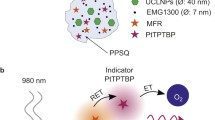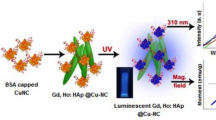Abstract
A new paramagnetic crystalline material, namely, lithium naphthalocyanine (LiNc), whose electron-paramagnetic-resonance (EPR) line width is highly sensitive to oxygen content, has been evaluated for use as oximetry probe in cells and tissues. Previously,we reported on the synthesis, structural framework,magnetic and oxygen-sensing properties of LiNc microcrystalline powder (Pandian et al, J. Mater. Chem. 19, 4138, 2009). The material exhibited a single, sharp EPR line that showed a highly linear response of its width to surrounding molecular oxygen (pO2) with a sensitivity of 31.2 mG/mmHg. In the present study, we evaluated the suitability of this material for in vivo oximetry in biological systems. We observed that the probe was stable in tissues for more than two months without any adverse effect on its oxygen-sensing properties. We further demonstrated that the probe can be prepared in sub-micron sizes for uptake by stem cells. Thus, the high oxygen sensitivity, biocompatibility, and long-term stability in tissues may be useful for high-resolution EPR oximetry.
Access this chapter
Tax calculation will be finalised at checkout
Purchases are for personal use only
Preview
Unable to display preview. Download preview PDF.
Similar content being viewed by others
References
Kulkarni AC, Kuppusamy P, Parinandi NL (2007) Oxygen, the lead actor in the pathophysiologic drama: enactment of the trinity of normoxia, hypoxia, and hyperoxia in disease and therapy. Antiox Redox Signal 9:1717-1730.
Tatum JL,Kelloff GJ,GilliesRJ et al (2006) Hypoxia: importance in tumor biology, noninvasive measurement by imaging, and value of its measurement in the management of cancer therapy. Int J Radiat Biol 82:699-757.
Ilangovan G, Zweier JL, Kuppusamy P (2000) Electrochemical preparation and EPR studies of lithium phthalocyanine: Evaluation of the nucleation and growth mechanism and evidence for potential-dependent phase formation. J Phys Chem B 104:4047-4059.
Pandian RP,Dolgos M, Dang V et al (2007) Structure and oxygen-sensing paramagnetic properties of a new lithium 1,8,15,22-tetraphenoxyphthalocyanine radical probe for biological oximetry. Chem Mater 19:3545-3552.
Pandian RP,Kim Y,Woodward PM et al (2006) The openmolecular framework of paramagnetic lithium octabutoxy-naphthalocyanine: implications for the detection of oxygen and nitric oxide using EPR spectroscopy. J Mater Chem 16:3609-3618.
Pandian RP, Parinandi NL, Ilangovan G et al (2003) Novel particulate spin probe for targeted determination of oxygen in cells and tissues. Free Radic Biol Med 35:1138-1148.
Ilangovan G,Manivannan A,Li H et al (2002)A naphthalocyanine-based epr probe for localized measurements of tissue oxygenation. Free Rad Biol Med 32:139-147.
Pandian RP, Dolgos M, Marginean C et al (2009) Molecular packing and magnetic properties of lithium naphthalocyanine crystal: hollow channels enabling permeability and paramagnetic sensitivity to molecular oxygen J Mater Chem 19:4138-4147.
Bratasz A, Pandian RP, Deng Y et al (2007) In vivo imaging of changes in tumor oxygenation during growth and after treatment. Magn Reson Med 57:950-959.
Wisel S, Chacko SM, Kuppusamy ML et al (2007) Labeling of skeletal myoblasts with a novel oxygen-sensing spin probe for noninvasive monitoring of in situ oxygenation and cell therapy in heart. Am J Physiol Heart Circ Physiol 292:H1254-1261.
Author information
Authors and Affiliations
Corresponding author
Editor information
Editors and Affiliations
Rights and permissions
Copyright information
© 2011 Springer Science+Business Media, LLC
About this paper
Cite this paper
Pandian, R.P., Chacko, S.M., Kuppusamy, M.L., Rivera, B.K., Kuppusamy, P. (2011). Evaluation of Lithium Naphthalocyanine (LiNc) Microcrystals for Biological EPR Oximetry. In: LaManna, J., Puchowicz, M., Xu, K., Harrison, D., Bruley, D. (eds) Oxygen Transport to Tissue XXXII. Advances in Experimental Medicine and Biology, vol 701. Springer, Boston, MA. https://doi.org/10.1007/978-1-4419-7756-4_5
Download citation
DOI: https://doi.org/10.1007/978-1-4419-7756-4_5
Published:
Publisher Name: Springer, Boston, MA
Print ISBN: 978-1-4419-7755-7
Online ISBN: 978-1-4419-7756-4
eBook Packages: Biomedical and Life SciencesBiomedical and Life Sciences (R0)




